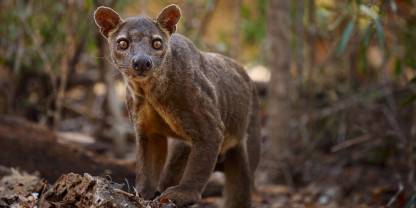Average Expert Rating
Rating Breakdown
Write a User ReviewFossas, Lemurs & Big-Bodied Baobabs
To get there, I travelled from the coastal town of Morandava along 60km of bumpy sand track through a landscape where giant baobabs stand like voluptuous sentinels over scrublands and rudimentary villages.
Along the way, I passed through the ‘Avenue of the Baobabs’; a famous locale where dozens of these peculiar trees are found clustered in close proximity to the road. They are ancient and massive, and awe-inspiring too. But they are also in danger of becoming extinct.
Once in the Kirindy forest itself, a spiderweb of hiking trails allows one to explore outwards from the main central camp. There, during the day, I came across troops of brown lemurs and families of bright white Verreaux’s sifakas as they moved through the
Read more
branches of myriad tree species. At dusk, I got lucky and found a small family of bushy-tailed Grandidier’s mongoose scuttling through the leaf litter.But it wasn’t until after nightfall that I encountered the animal I had come all the way to Kirindy in the hopes of seeing. A fossa; Madagascar’s only predator of notable size.
Kirindy is known as being the best place in all of Madagascar to see these elusive predators, and what’s more, they are often found close to camp and are unafraid of humans.
Madagascar’s Home of the Fossa
The forest also protects eight species of lemur, including the fork-marked lemur, Coquerel’s dwarf lemur and Madame Berthe’s mouse lemur; the latter is one of the world’s smallest primates. Birds are another highlight with 45 species, including the much-sought-after Madagascar pygmy kingfisher. But what I really
Read more
love about Kirindy is the overall importance of the place and its backstory. This relatively compact island of community-protected, wildlife-rich forest is a last refuge in a sea of deforestation – where the reserve ends, so too does the forest, revealing an empty stretch to the horizon.Fossas and Baobabs
Not to be confused with the more southerly national park of the same name, this small privately managed forest reserve and research centre 65km north of Morondava is widely billed as the most reliable site for seeing the fossa, Madagascar’s largest carnivore. Based on our one visit, the reputation is more than justified. We were not there during the mating season of September to November, when these handsome nocturnal hunters are most active, but we still had a few excellent and photogenic daylight sightings of fossa around the low-key camp. We also did a short forest walk that rewarded us with some good lemur sightings, but we missed out on seeing the alluring and highly localised Malagasy giant rat, a rabbit-sized endemic that can leap a metre into the air to escape predators. A must-see en route between Morondava and Kirindy is the so-called Avenue des Baobabs, a strikingly photogenic site that comprises around 20 Grandidier's baobabs that stand up to 30m tall and are thought to be up to 800 years old.
Fossas in Love
I went to Kirindy Forest in the hope of seeing Madagascar’s largest predator, the fossa. Although widespread and present in most of the island’s parks and reserves, this secretive creature is rarely seen. I was told that Kirindy would be my best bet as there are several individuals there that have become habituated to humans. The rumors proved to be true. I had only just arrived when a cheeky fossa strolled past my cottage in broad daylight. Unlike the national parks, Kirindy is privately managed, so you are allowed to walk around unguided. This was a nice change from the packaged activities elsewhere and it gave me an opportunity to follow the fossa doing fossa-things for the whole day. I would love to come back here sometime during their mating season from September to November. At this time, a female occupies a suitable ‘mating tree’ for about a week during which she mates with many males for extended periods of up to two hours at a time. Males congregate beneath the trees calling for the female’s attention.

